
Spring Boot empfiehlt offiziell die Verwendung von Thymeleaf als Template-Engine. SpringBoot bietet eine Reihe von Standardkonfigurationen für Thymeleaf und einen View-Resolver für Thymeleaf. Sobald die Abhängigkeiten von Thymeleaf in das Projekt importiert werden, wird die entsprechende automatische Konfiguration (ThymeleafAutoConfiguration) automatisch wirksam, sodass Thymeleaf perfekt in Spring Boot integriert werden kann. Die Thymeleaf-Vorlagen-Engine kann perfekt mit HTML-Tags kombiniert werden, um das Backend-Rendering von Daten zu erleichtern. Thymeleaf unterstützt statische Effekte und dynamische Effekte Wenn keine dynamischen Daten vorhanden sind, werden statische Effekte angezeigt. Die Vorlagen-Engine dient dazu, die Benutzeroberfläche von Geschäftsdaten (Inhalten) zu trennen Die Template-Engine der Website generiert ein Standard-HTML-DokumentEs dient dazu, mithilfe der Template-Datei und der Daten einen HTML-Code über die Template-Engine zu generieren **Gemeinsame Template-Engines sind: jsp, freemarker, Velocity, Thymeleaf Der Standard-Schreibort von Thymeleaf befindet sich auf der offiziellen Website von templates Thymeleaf in diesem Verzeichnis: https://www.thymeleaf.org/
<dependency> <groupId>org.springframework.boot</groupId> <artifactId>spring-boot-starter-thymeleaf</artifactId> </dependency>
Der Standardansichtspfad von Thymeleaf lautet: / resources/templates. Erstellen Sie HTML in diesem Verzeichnis und stellen Sie thymeleaf
<html lang="en" xmlns:th="http://www.thymleaf.org">
xmlns:th vor ="http://www.thymleaf.org“>
${domain attribute name}: Rufen Sie den Domänenattributwert in der Anforderungsdomäne ab und zeigen Sie ihn an
${session.domain attribute name}: Holen Sie sich den Attributwert und die Anzeige der Domäne in der Sitzungsdomäne.
th: Texttextersetzung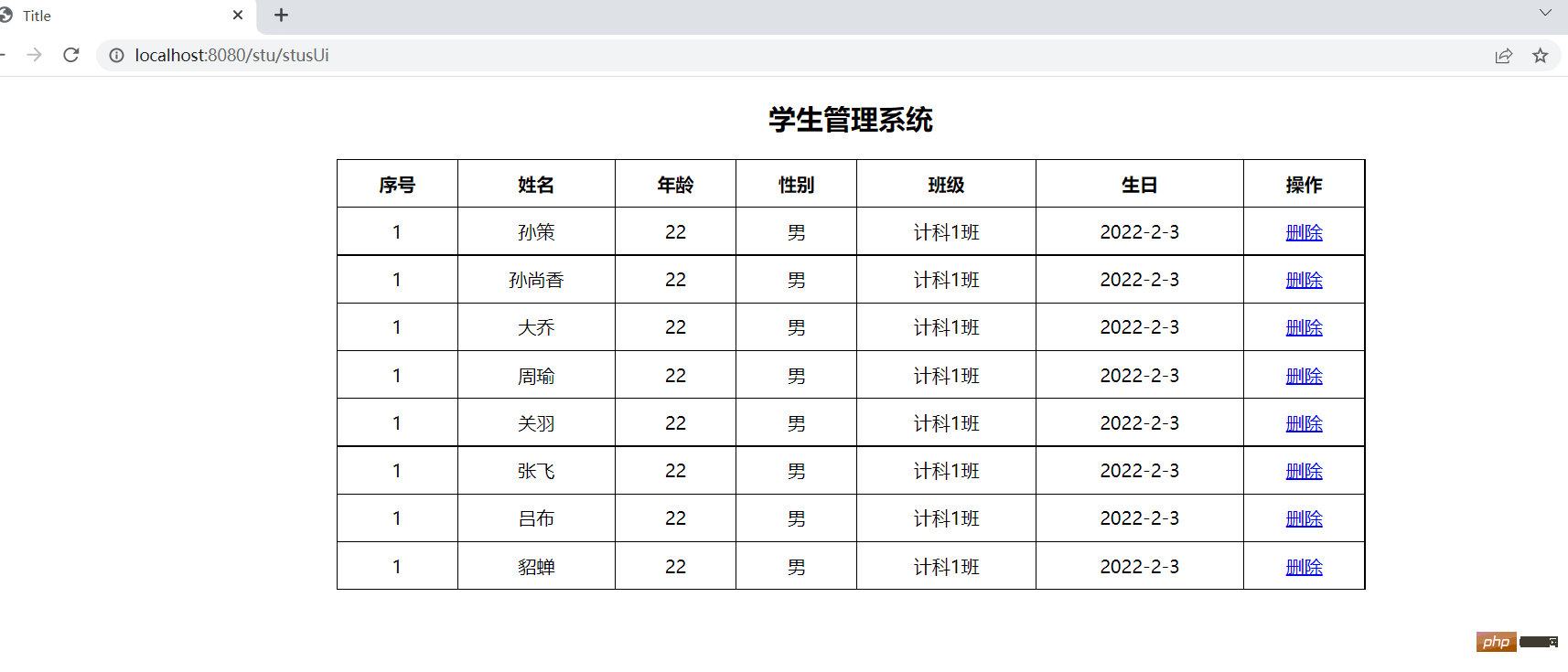
< p th:text="${name}">aaa</p><span th:text="${user.name}">Tom</span>thymeleaf verwendet standardmäßig den Variablennamen + StatistikstatusWenn die Statusvariable nicht explizit festgelegt ist, verwendet thymeleaf standardmäßig einen Variablennamen + Statistikstatus
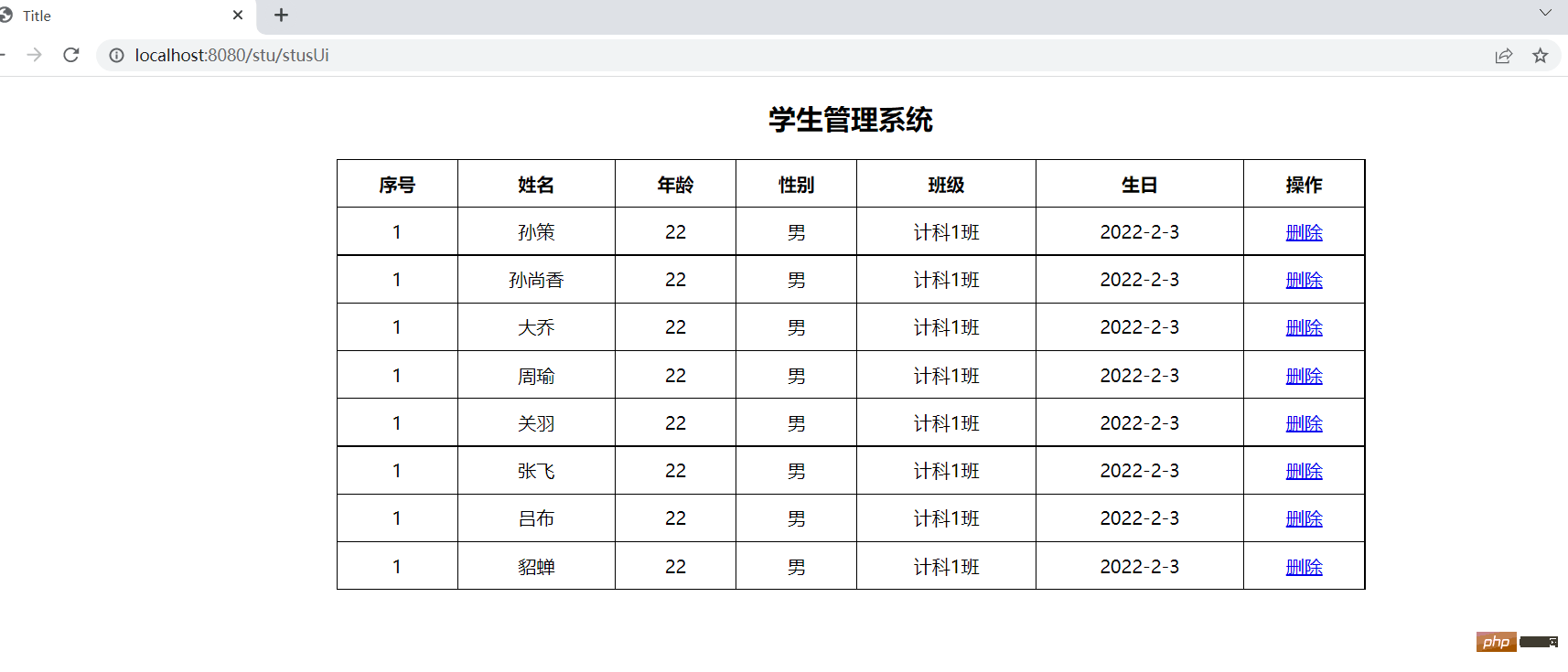
<h3 th:if="${age>=18}">成年</h3>
<h3 th:unless="${age>=18}">未成年</h3>th:id, th:value, th :checked usw. (bezogen auf das Formular)
th:object kann Objektattribute definieren*
{} kann in Verbindung mit th:object verwendet werden, um die Attribute im Objekt zu extrahieren#dates.format () kann zum Formatieren des Datumsformats verwendet werden.
<html lang="en" xmlns:th="http://www.thymleaf.org">
Title
学生管理系统
| 序号 | 姓名 | 年龄 | 性别 | 班级 | 生日 | 操作 |
|---|---|---|---|---|---|---|
| 1 | aa | 22 | 男 | 计科1班 | 2022-2-3 | 删除 |
Dann verwenden wir hier den Druid-Verbindungspool, also müssen wir ihn in die POM-Datei importieren. Relevante AbhängigkeitenDann müssen wir relevante Konfigurationen in der globalen Konfigurationsdatei application.properties<!--http://localhost:8080/stu/10 --> <a th:href="${'/stus/'+ stu.id}" rel="external nofollow" >编辑学生1</a> <!--http://localhost:8080/stu?id=10 --> <a th:href="@{/stus(id=${stu.id})}" rel="external nofollow" >编辑学生2</a> <!--http://localhost:8080/stu?id=10&name=abc --> <a th:href="@{/stus(id=${stu.id},name=${stu.name})}" rel="external nofollow" >编辑学生3</a>Nach dem Login kopieren
<div th:switch="${stu.role}">
<h3 th:case="banzhang">班长</h3>
<h3 th:case="tuanzhishu">团支书</h3>
<h3 th:case="${data}">学委</h3>
<h3 th:case="*">其他</h3>
</div><tr th:each="stu: ${stus}">
<td th:text="${stuStat.index}"></td>
<td th:text="${ stu.name}"></td>
<td th:text="${ stu.age}"></td>
</tr>thymeleaf
<form th:object="${stu}"> 编号:<input type="text" name="id" th:value="*{id}"><br> 姓名:<input type="text" name="name" th:value="*{name}"><br> 年龄:<input type="text" name="age" th:value="*{age}"><br> 性别:<input type="radio" name="gender" value="true" th:checked="*{gender}">男<br> 性别:<input type="radio" name="gender" value="true" th:checked="*{not gender}">女<br> 生日:<input type="text" name="birth" th:value="*{#dates.format(birth,'yyyy-MM-dd')}"><br> <input type="submit" value="编辑"> </form>Nach dem Login kopieren
Controller<dependency> <groupId>com.alibaba</groupId> <artifactId>druid-spring-boot-starter</artifactId> <version>1.2.11</version> </dependency>Nach dem Login kopieren
Dann bereiten wir zuerst die Seite vor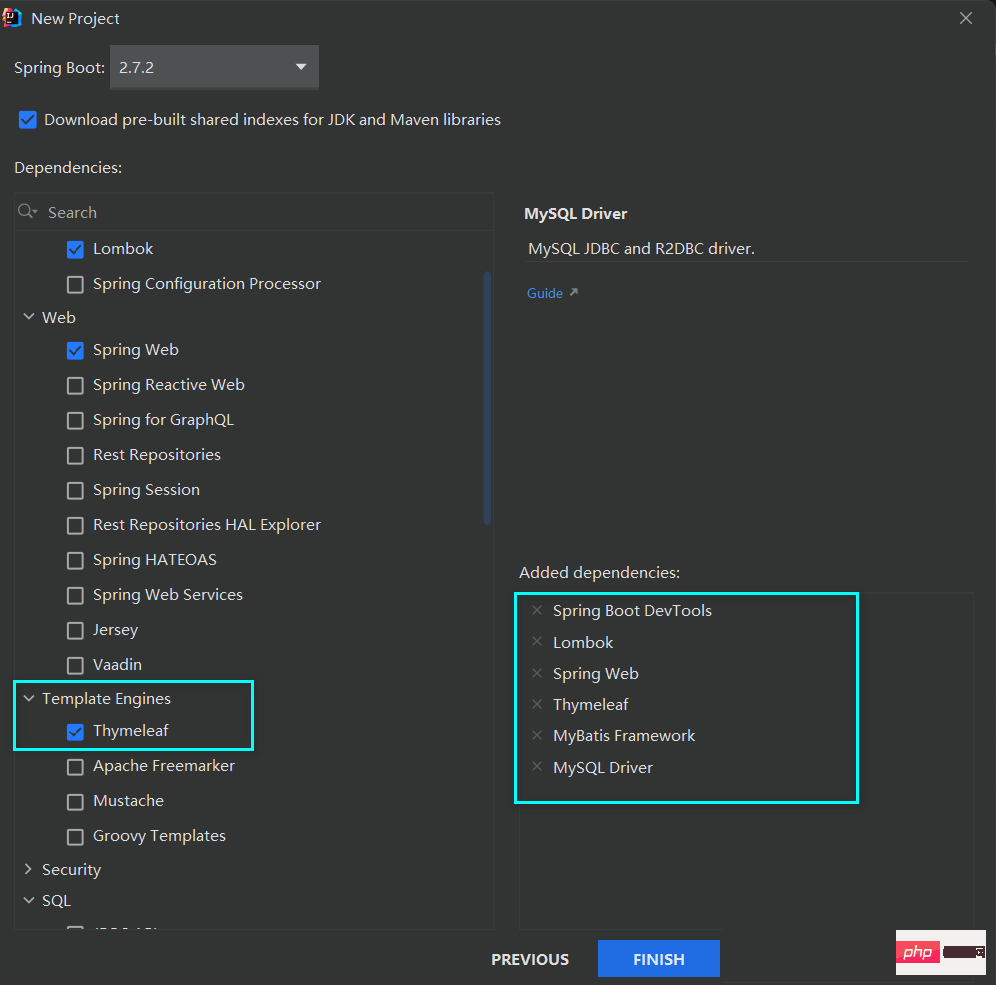
# 指定Mybatis的Mapper接口的xml映射文件的路径 mybatis.mapper-locations=classpath:mapper/*xml # MySQL数据库驱动 #这个驱动也可以省略,可以根据使用的MySQL自动加载相应的驱动 spring.datasource.driver-class-name=com.mysql.cj.jdbc.Driver # 数据源名称 spring.datasource.name=com.alibaba.druid.pool.DruidDataSource # 数据库连接地址 spring.datasource.url=jdbc:mysql://localhost:3306/school?serverTimezone=UTC&zeroDateTimeBehavior=convertToNull # 数据库用户名和密码 spring.datasource.username=root spring.datasource.password=a87684009. # 设置日志级别 logging.level.com.zyh.springboot=debug # 开启mybatis驼峰命名规则自动转换功能 mybatis.configuration.map-underscore-to-camel-case=true
Controller (die vorherige Methode wird hier nicht eingefügt). , sonst gibt es zu viel Code)Löschvorgang
@Data
public class Stu {
private Integer id;
private String name;
private Integer age;
private Boolean gender;
private Integer cid;
@DateTimeFormat(pattern = "yyyy-MM-dd")
private Date birth;
}Service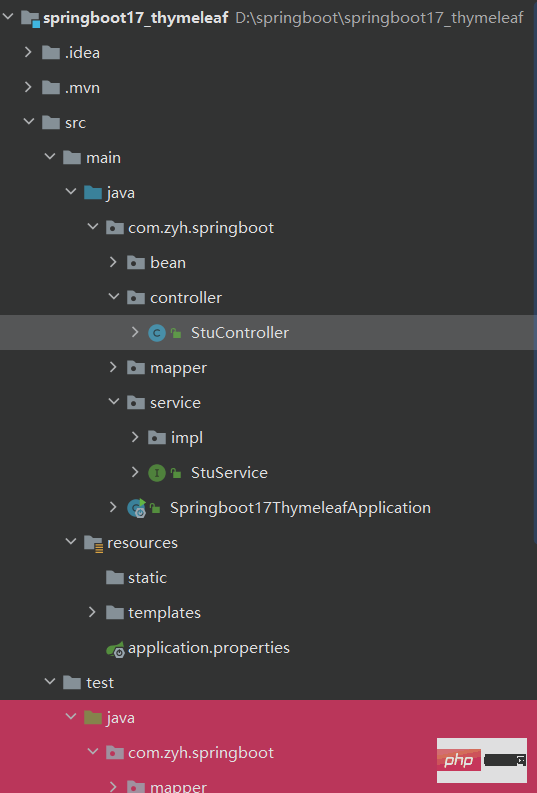
@Mapper
public interface StuMapper {
/**
* 查询所有学生信息
* @return
* @throws Exception
*/
@Select("select * from stu")
List<Stu> queryAllStu() throws Exception;
}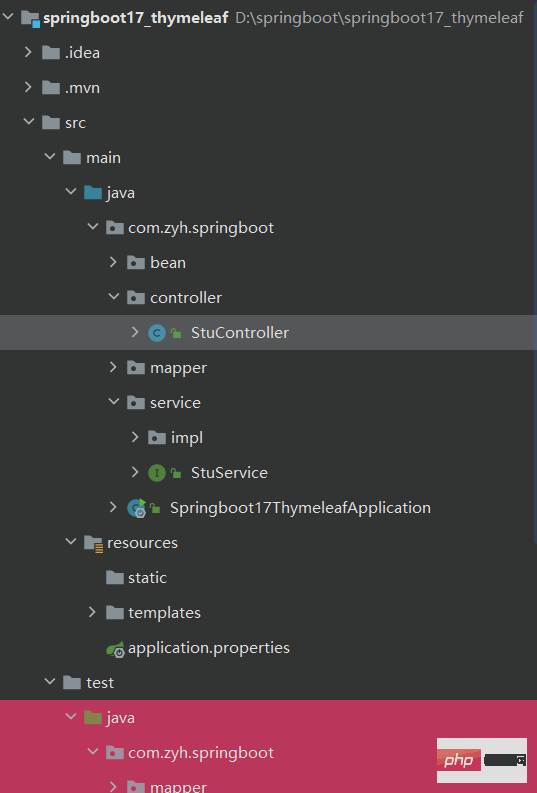 Service-Implementierungsklasse
Service-Implementierungsklasse
public interface StuService {
/**
* 查询所有学生信息
* @return
*/
List<Stu> queryAllStu() throws Exception;
}Mapper
@Service
public class StuServiceImpl implements StuService {
@Autowired
private StuMapper stuMapper;
@Override
public List<Stu> queryAllStu() throws Exception {
return stuMapper.queryAllStu();
}
}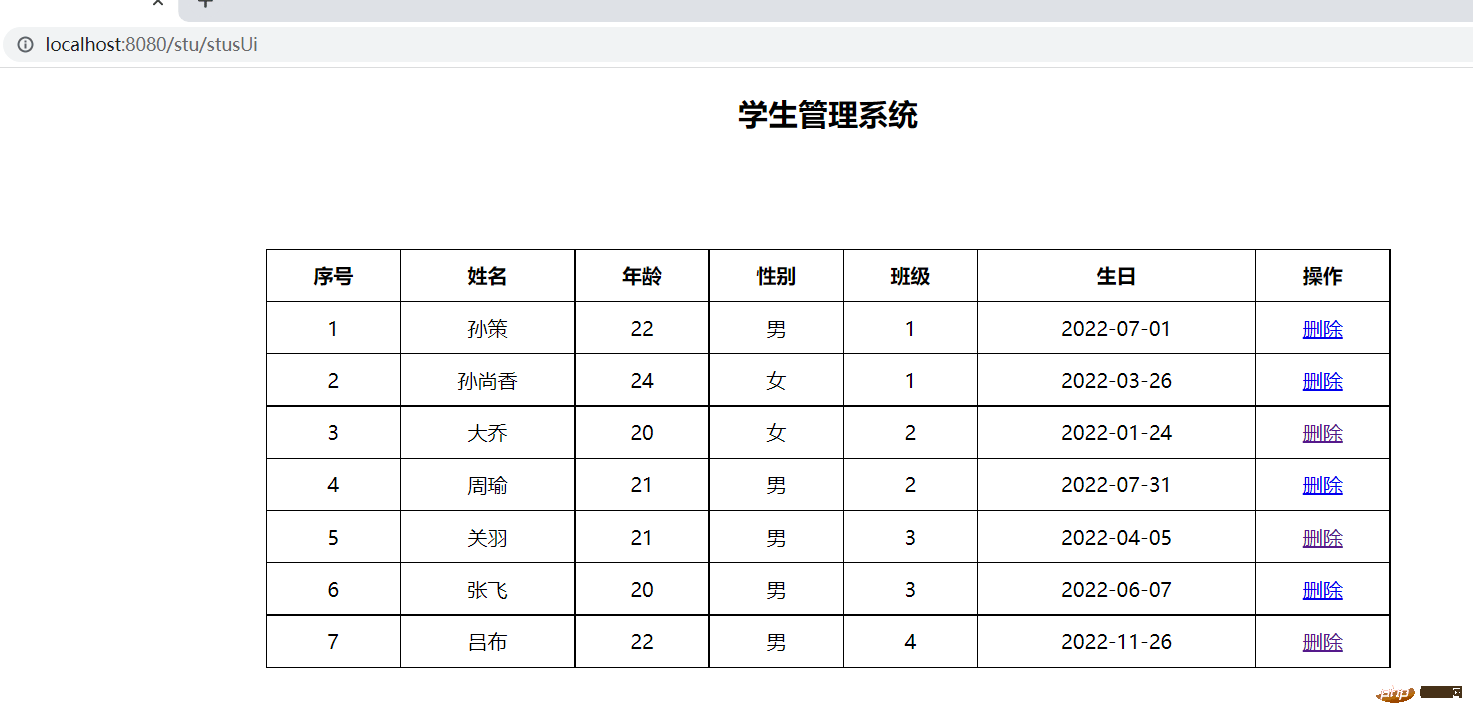
页面stus.html
<!DOCTYPE html>
<html lang="en" xmlns:th="http://www.thymeleaf.org">
<head>
<meta charset="UTF-8">
<title>Title</title>
<style>
.tb-stus{
width: 900px;
margin: 0 auto;
border: black 1px solid;
border-collapse: collapse;
}
.tb-stus th,td{
padding: 10px;
text-align: center;
border:1px solid black;
}
</style>
</head>
<body>
<h3 align="center">学生管理系统</h3>
<table class="tb-stus">
<thead>
<tr>
<th>序号</th>
<th>姓名</th>
<th>年龄</th>
<th>性别</th>
<th>班级</th>
<th>生日</th>
<th>操作</th>
</tr>
</thead>
<tbody>
<tr th:each="stu,status: ${stuList}">
<td th:text="${stu.id}">1</td>
<td th:text="${stu.name}">aa</td>
<td th:text="${stu.age}">22</td>
<!-- gender的属性值为1表示性别为男-->
<td th:if="${stu.gender}">男</td>
<td th:unless="${stu.gender}">女</td>
<td th:text="${stu.cid}">计科1班</td>
<td th:text="${#dates.format(stu.birth,'yyyy-MM-dd')}">2022-2-3</td>
<td>
<!-- localhost:8080/stu/delete/8-->
<!-- <a th:href="${'/stu/delete/'+stu.id}" rel="external nofollow" rel="external nofollow" >删除</a>-->
<!--http://localhost:8080/stu/delete?id=10-->
<a th:href="@{/stu/delete(id=${stu.id})}" rel="external nofollow" rel="external nofollow" rel="external nofollow" >删除</a>
<a th:href="@{/stu/edit(id=${stu.id})}" rel="external nofollow" rel="external nofollow" >编辑</a>
</td>
</tr>
</tbody>
</table>
</body>
</html>页面 stu-edit.html
<!DOCTYPE html>
<html lang="en" xmlns:th="http://www.thymeleaf.org">
<head>
<meta charset="UTF-8">
<title>编辑画面</title>
</head>
<body>
<h3 >编辑学生信息</h3>
<form action="" method="post" th:object="${stu}">
学号:<input type="text" name="id" th:value="*{id}" ><br><br>
姓名:<input type="text" name="name" th:value="*{name}"><br><br>
年龄:<input type="text" name="age" th:value="*{age}"><br><br>
性别:<input type="radio" name="gender" th:checked="*{gender}" >男
<input type="radio" name="gender" th:checked="*{!gender}" >女<br><br>
班级:<input type="text" name="cid" th:value="*{cid}"><br><br>
生日:<input type="text" name="birth" th:value="*{#dates.format(birth,'yyyy-MM-dd')}"><br><br>
<input type="submit" value="编辑">
</form>
</body>
</html>Controller
/**
* 根据id来修改数据
* 我们首先得先根据id把数据查询出来,然后把数据展示出来
* 用户再进行编辑,用户编辑完并且提交以后,跳转到学生管理系统画面,展示所有数据
* @return
*/
@RequestMapping("/edit")
public String edit(@RequestParam("id") Integer id,Model model){
System.out.println("id"+id);
try {
Stu stu=stuService.queryById(id);
model.addAttribute("stu",stu);
} catch (Exception e) {
e.printStackTrace();
}
return "stu-edit";
}Service
public interface StuService {
/**
* 查询所有学生信息
* @return
*/
List<Stu> queryAllStu() throws Exception;
/**
* 根据id来删除学生信息
* @param id
* @throws Exception
*/
void deleteByid(Integer id) throws Exception;
/**
* 根据id来查询对应学生信息
* @param id
* @return
* @throws Exception
*/
Stu queryById(Integer id) throws Exception;
}Service实现类
@Service
public class StuServiceImpl implements StuService {
@Autowired
private StuMapper stuMapper;
@Override
public List<Stu> queryAllStu() throws Exception {
return stuMapper.queryAllStu();
}
/**
* 根据id删除数据
* @param id
*/
@Override
public void deleteByid(Integer id) throws Exception {
stuMapper.deleteById(id);
}
@Override
public Stu queryById(Integer id) throws Exception {
return stuMapper.queryById(id);
}
}Mapper
@Mapper
public interface StuMapper {
/**
* 查询所有学生信息
* @return
* @throws Exception
*/
@Select("select * from stu")
List<Stu> queryAllStu() throws Exception;
@Delete("delete from stu where id=#{id}")
void deleteById( Integer id);
@Select("select * from stu where id=#{id}")
Stu queryById(Integer id) throws Exception;
}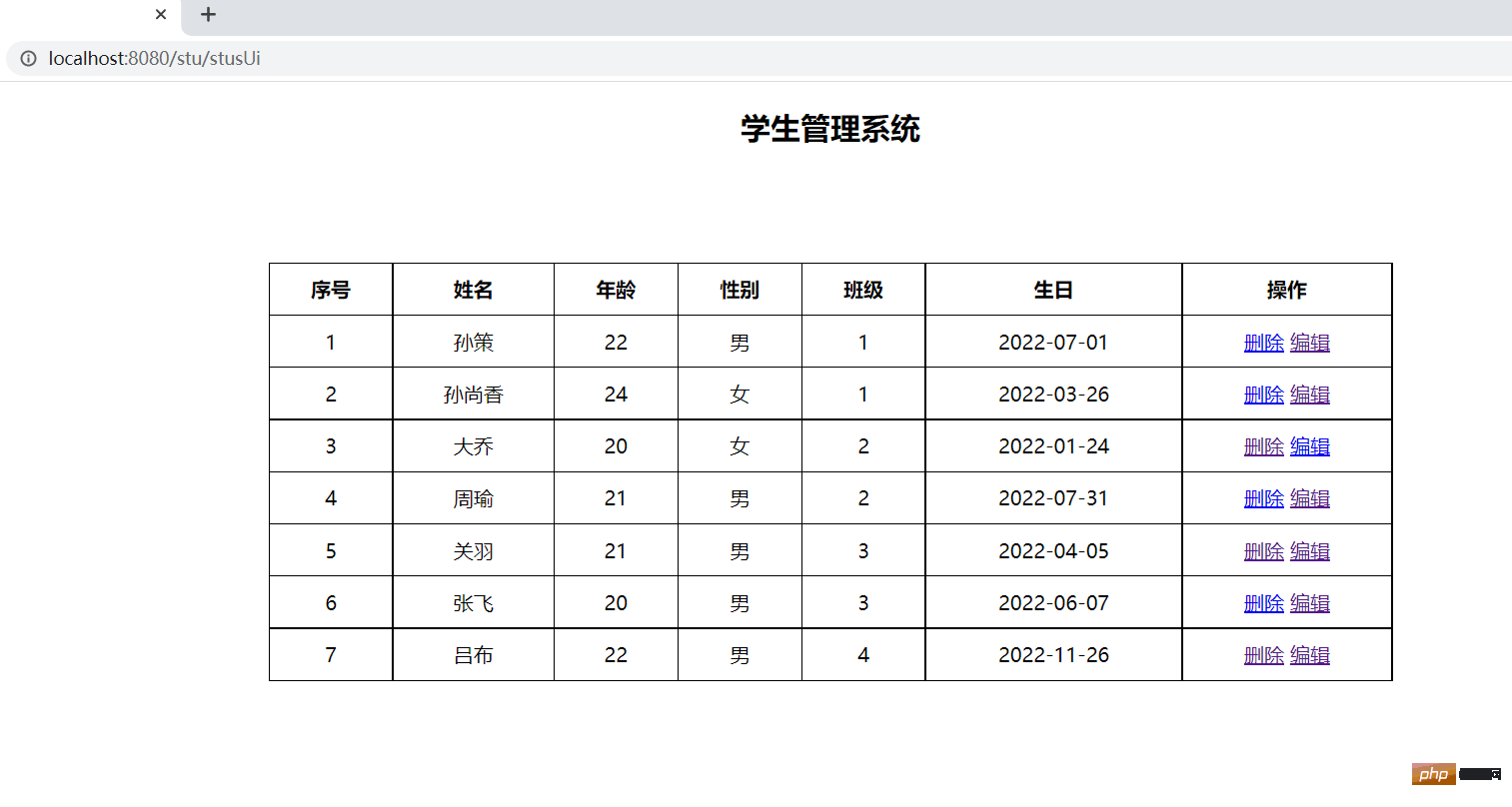
比如在序号为4中,点击编辑
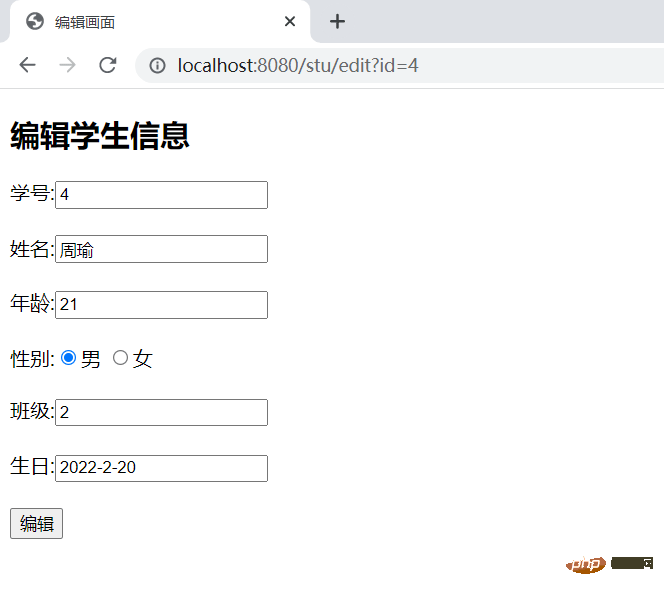
登录页面:
<!DOCTYPE html>
<html lang="en">
<head>
<meta charset="UTF-8">
<title>Title</title>
</head>
<body>
<h3>用户登录</h3>
<form action="/login" method="post">
账号:<input type="text" name="username"><br><br>
密码:<input type="password" name="password"><br><br>
<input type="submit" value="登录">
</form>
</body>
</html>因为需要判断用户是否存在,这是从数据库进行查询的,所以要准备对应的管理员表
# 创建管理员表 CREATE TABLE admin( id INT PRIMARY KEY AUTO_INCREMENT, username VARCHAR(20), `password` VARCHAR(20) ); INSERT INTO admin VALUES (DEFAULT,'aaa',111), (DEFAULT,'bbb',222), (DEFAULT,'ccc',333); # 查询测试 SELECT * FROM admin;
准备对应的实体类
@Data
public class Admin {
private String username;
private String password;
}Controller
@Controller
@SessionAttributes(names = {"admin"})
public class AdminController {
@Autowired
private AdminService adminService;
/**
* 显示登录页面
* @return
*/
@RequestMapping(value = "/loginUi")
public String loginUi(){
return "login";
}
@RequestMapping(value = "/login",method = RequestMethod.POST)
public String login(String username, String password, Model model){
try {
Admin admin = adminService.login(username, password);
//用户名存在说明登录成功
if (admin!=null){
//存放到session域中
model.addAttribute("admin",admin);
return "redirect:/stu/stusUi";
}
} catch (Exception e) {
e.printStackTrace();
}
return "redirect:/loginUi";
}
}Service
public interface AdminService {
Admin login(String username,String password) throws Exception;
}Service对应的实现类
@Service
public class AdminServiceImpl implements AdminService {
@Autowired
private AdminMapper adminMapper;
@Override
public Admin login(String username, String password) throws Exception {
return adminMapper.queryByUsernameAndPassword(username,password);
}
}Mapper
@Mapper
public interface AdminMapper {
@Select("select * from admin where username=#{username} and password=#{password}")
Admin queryByUsernameAndPassword(@Param("username") String username, @Param("password") String password);
}
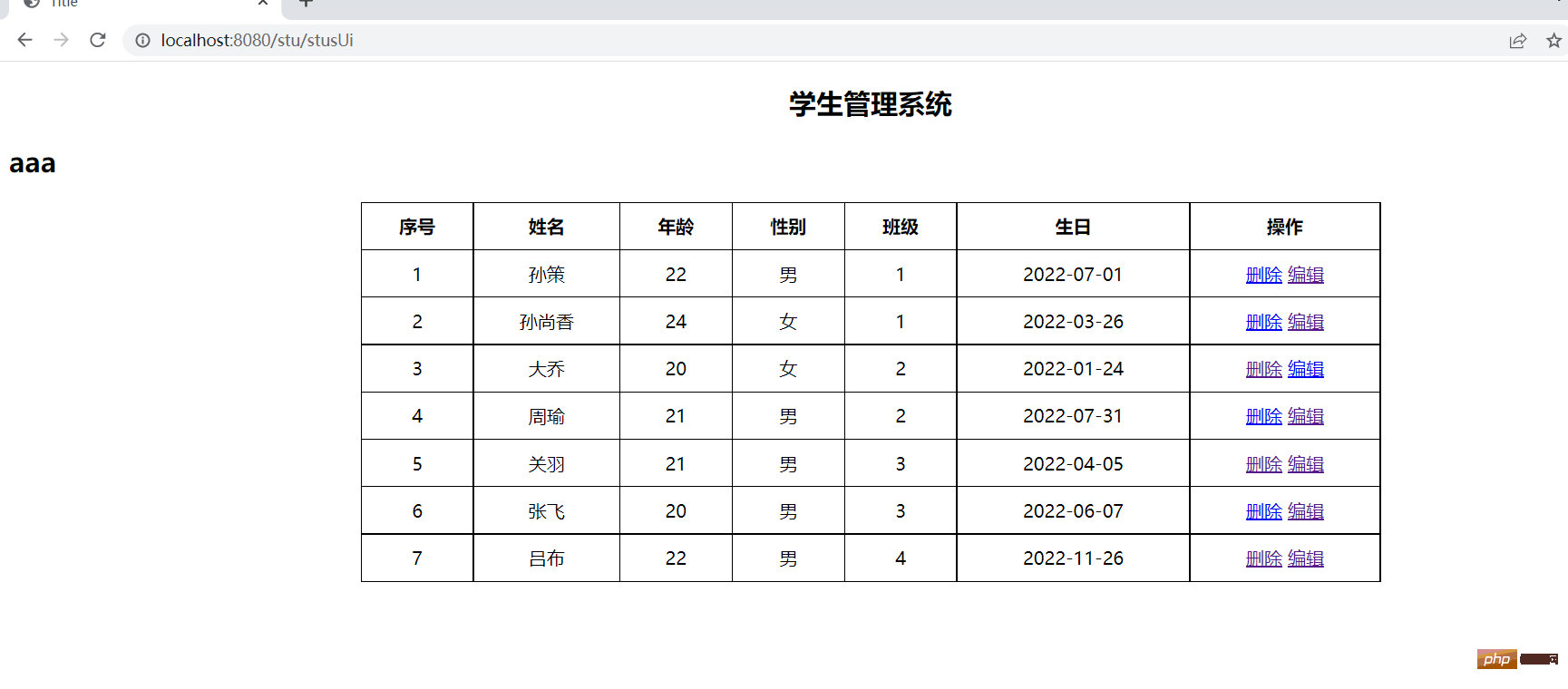
<!DOCTYPE html>
<html lang="en" xmlns:th="http://www.thymeleaf.org">
<head>
<meta charset="UTF-8">
<title>Title</title>
<style>
.tb-stus{
width: 900px;
margin: 0 auto;
border: black 1px solid;
border-collapse: collapse;
}
.tb-stus th,td{
padding: 10px;
text-align: center;
border:1px solid black;
}
</style>
</head>
<body>
<h3 align="center">学生管理系统</h3>
<h3 th:if="${session.admin!=null}" th:text="${session.admin.username}">用户名</h3>
<a th:unless="${session.admin!=null}" href="/loginUi" rel="external nofollow" >登录</a>
<a th:if="${session.admin!=null}" href="/logout" rel="external nofollow" >注销用户</a>
<table class="tb-stus">
<thead>
<tr>
<th>序号</th>
<th>姓名</th>
<th>年龄</th>
<th>性别</th>
<th>班级</th>
<th>生日</th>
<th>操作</th>
</tr>
</thead>
<tbody>
<tr th:each="stu,status: ${stuList}">
<td th:text="${stu.id}">1</td>
<td th:text="${stu.name}">aa</td>
<td th:text="${stu.age}">22</td>
<!-- gender的属性值为1表示性别为男-->
<td th:if="${stu.gender}">男</td>
<td th:unless="${stu.gender}">女</td>
<td th:text="${stu.cid}">计科1班</td>
<td th:text="${#dates.format(stu.birth,'yyyy-MM-dd')}">2022-2-3</td>
<td>
<!-- localhost:8080/stu/delete/8-->
<!-- <a th:href="${'/stu/delete/'+stu.id}" rel="external nofollow" rel="external nofollow" >删除</a>-->
<!--http://localhost:8080/stu/delete?id=10-->
<a th:href="@{/stu/delete(id=${stu.id})}" rel="external nofollow" rel="external nofollow" rel="external nofollow" >删除</a>
<a th:href="@{/stu/edit(id=${stu.id})}" rel="external nofollow" rel="external nofollow" >编辑</a>
</td>
</tr>
</tbody>
</table>
</body>
</html>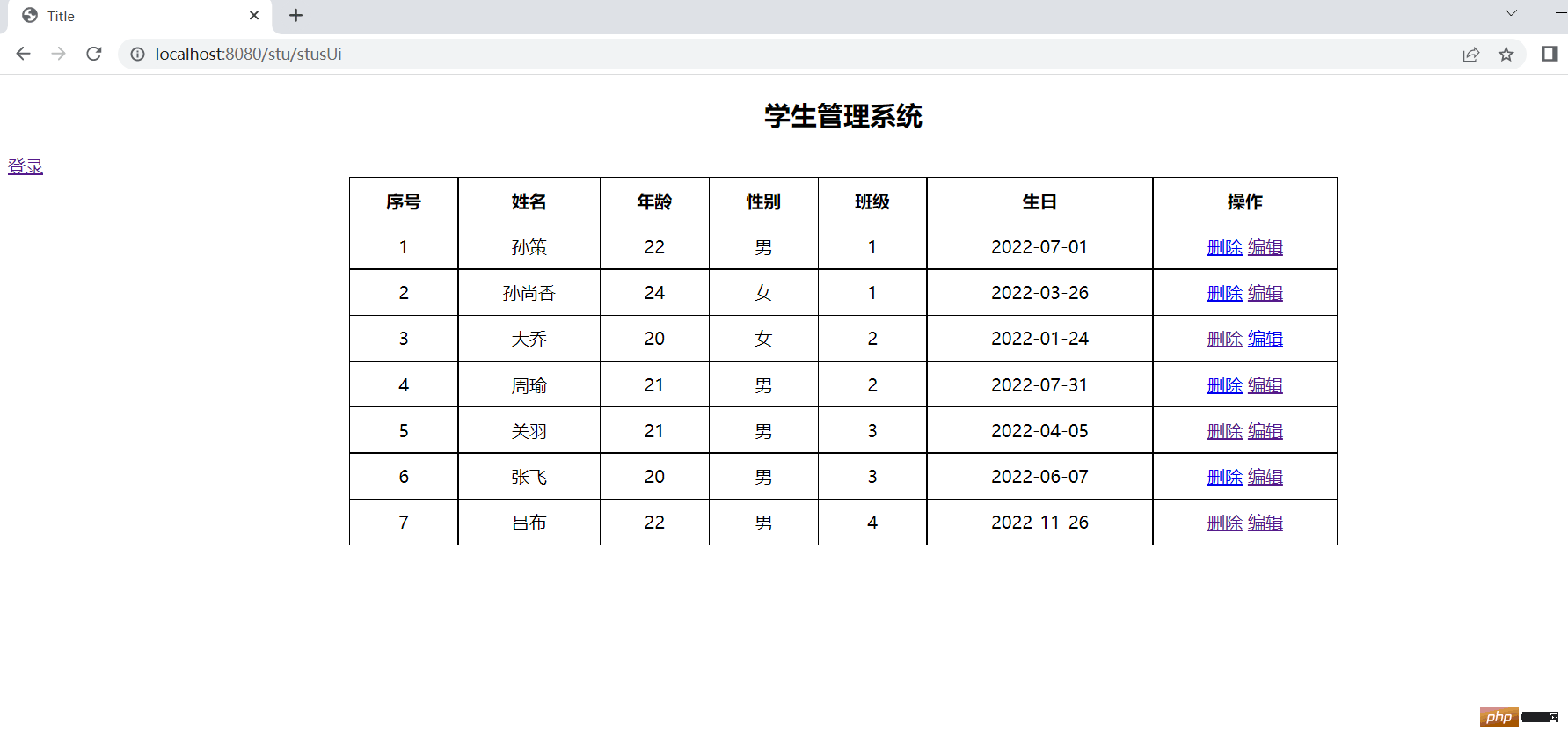

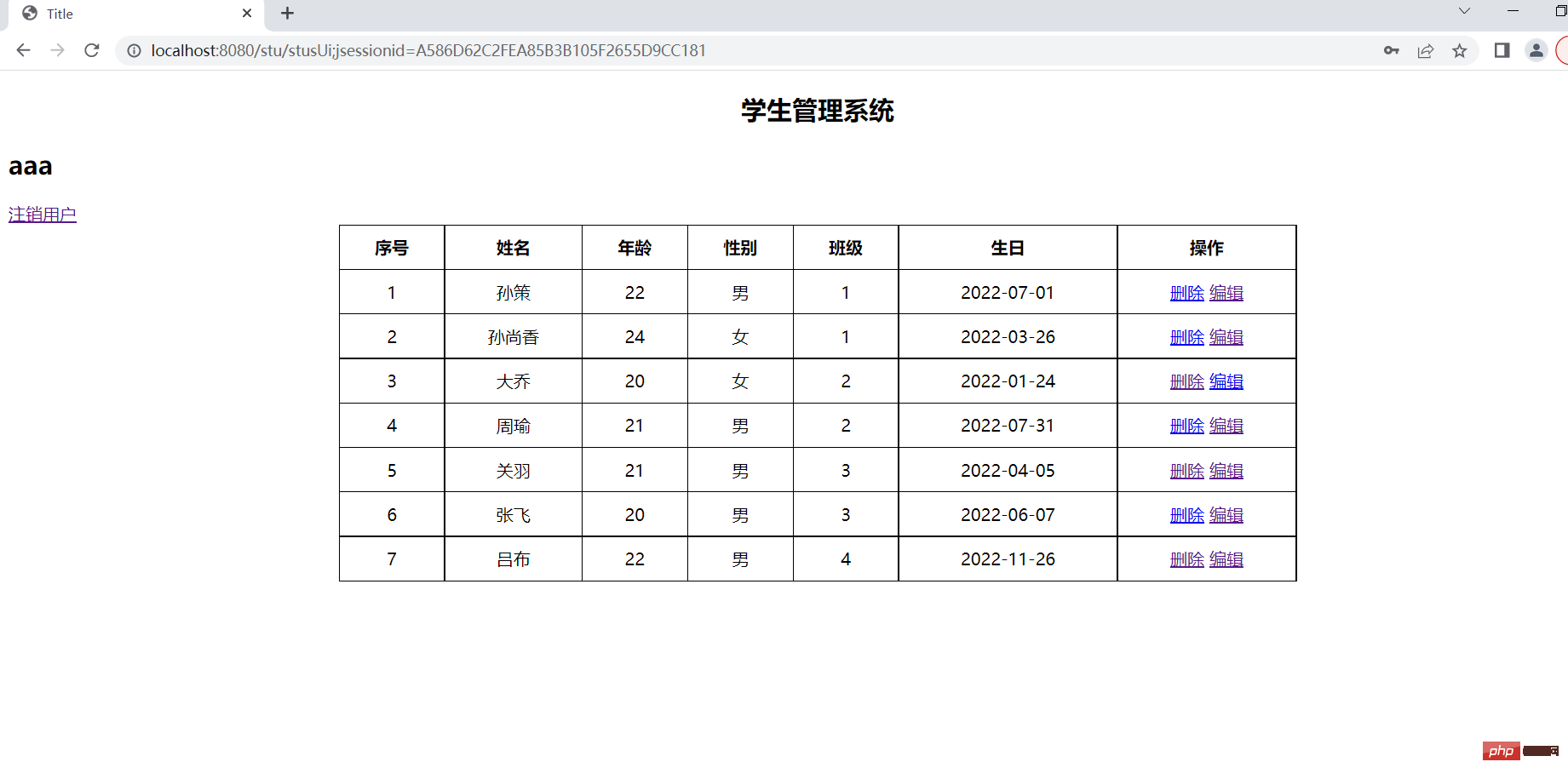
注销的话,我们把session域中的用户对象取消,然后这个时候就得重新登录,应该要跳转到登录画面
@RequestMapping("/logout")
public String logout(HttpSession session){
session.removeAttribute("admin");
return "redirect:/loginUi";
}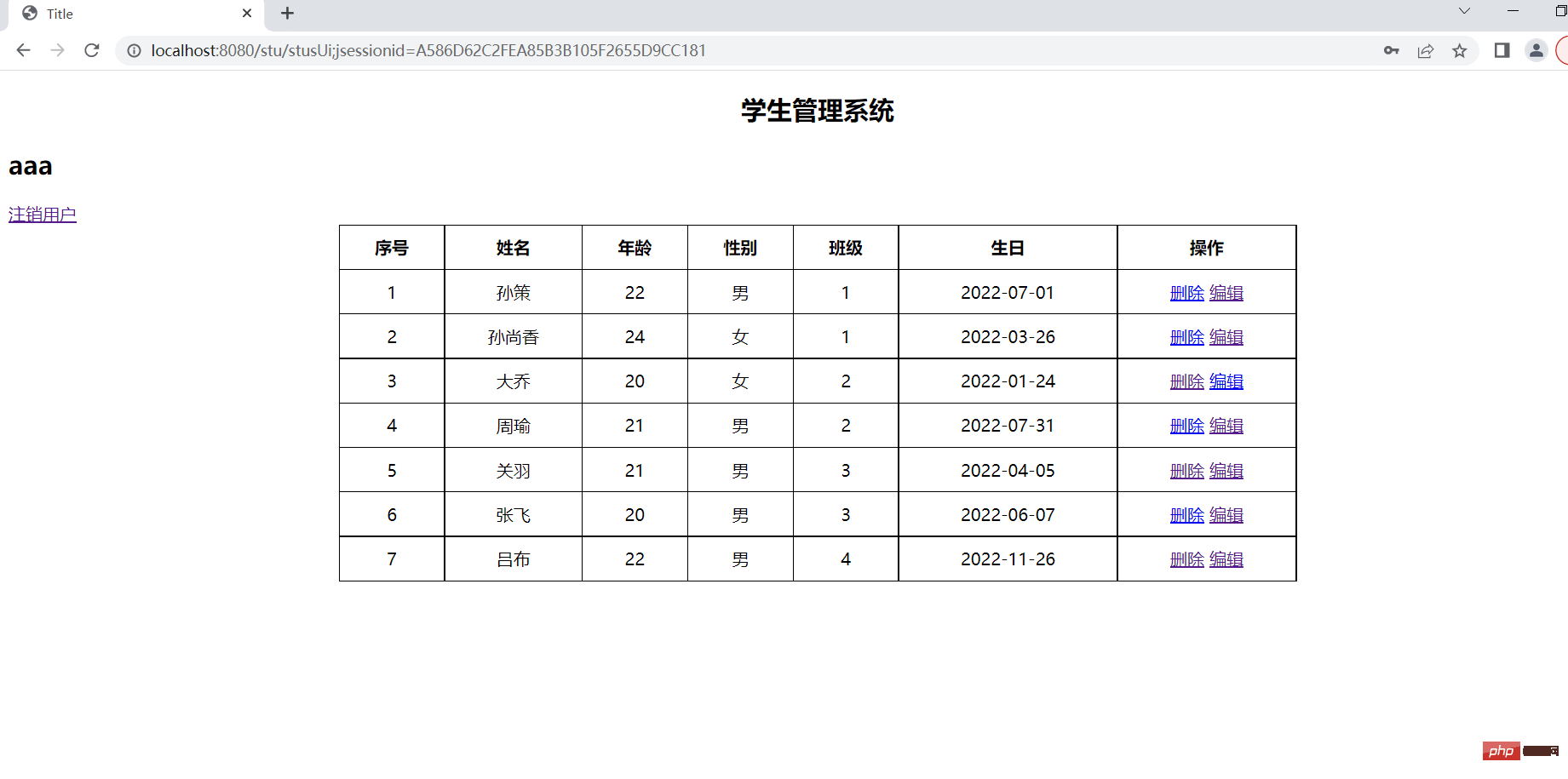

Das obige ist der detaillierte Inhalt vonWie Spring Boot Thymeleaf integriert. Für weitere Informationen folgen Sie bitte anderen verwandten Artikeln auf der PHP chinesischen Website!
 Schritte zur SpringBoot-Projekterstellung
Schritte zur SpringBoot-Projekterstellung
 Was ist der Unterschied zwischen j2ee und springboot?
Was ist der Unterschied zwischen j2ee und springboot?
 So verwenden Sie eine Python-for-Schleife
So verwenden Sie eine Python-for-Schleife
 So lösen Sie das Problem, dass die Datei msxml6.dll fehlt
So lösen Sie das Problem, dass die Datei msxml6.dll fehlt
 Was ist Python-Programmierung?
Was ist Python-Programmierung?
 So verwenden Sie die Vlookup-Funktion
So verwenden Sie die Vlookup-Funktion
 Was ist eine gespeicherte MYSQL-Prozedur?
Was ist eine gespeicherte MYSQL-Prozedur?
 So schreiben Sie eine API-Schnittstelle
So schreiben Sie eine API-Schnittstelle




